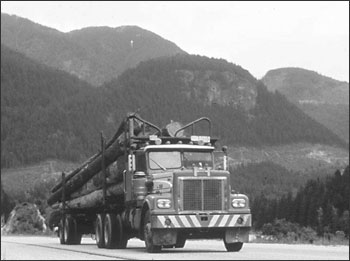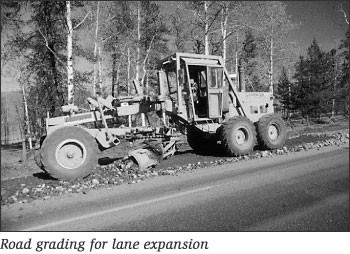 |
|
|
 |
 |
2002/03 Annual Service
Plan Report
Ministry of Transportation |
 |
 |
Ministry Role and Services
Introduction
The role of the Ministry of Transportation is to support B.C.'s
regions and industries by working to keep their transportation system
safe and cost effective.
The ministry is responsible for building, operating and managing
the provincial highway system, including inland ferries. The ministry's
role in this regard has shifted over time: away from direct delivery
of highway maintenance, routine design work and construction; and
towards planning, establishing partnerships, setting standards and
auditing results. This trend accelerated in 2002/03, allowing
the ministry to reduce its full-time equivalent (FTE) staff complement
from about 2,300 to just under 1,550, and remain on course to meet
its target of 966 FTEs by 2004/05.
The ministry works with local authorities and the private sector
to develop various forms of transportation improvements in support
of economic development, such as improvements to local airports.
It provides policy advice to the government on air, rail and marine
issues.
Up until the end of 2002/03, the ministry also served as an oversight
and appeals body on the licensing and testing of all B.C. drivers,
through the Office of the Superintendent of Motor Vehicles.
The independent Motor Carrier Commission regulates the commercial
passenger industry on B.C. highways and local roads.
The ministry's business also includes the BC Transportation Financing
Authority (BCTFA), a Crown corporation incorporated under the
Build BC Act, which owns and finances provincial transportation
assets. The BCTFA's chair is the Minister of Transportation, and
its CEO is the Deputy Minister of Transportation.
The Minister of Transportation is responsible for British Columbia
Railway Company, BC Transit, and Rapid Transit Project 2000.
These Crown-owned entities prepare their own annual service plan
reports. The Minister was also responsible for BC Ferries until
it was restructured and placed under the supervision of an independent
authority on April 1, 2003.
Ministry Vision, Mission and Values
Vision
The vision of the Ministry of Transportation is a fully integrated
transportation system that advances economic and social growth,
and moves goods and people within British Columbia and to markets
beyond.
Mission
The mission of the Ministry of Transportation is to:
- create an integrated transportation network that incorporates
all modes of transport, reflects regional priorities, and provides
a strong foundation for economic growth; and
- maintain and improve the provincial highway system, ensuring
the safe and efficient movement of people and goods provincially,
nationally and internationally.
Values
- We respect regional and community goals and priorities.
- We are responsive to the needs of British Columbia business.
- We strive for excellence and innovation.
- We respect the people we serve and work with.
The ministry refined the definitions of its vision, mission and
values during 2002/03; however, the themes that were established
in the 2002/03 – 2004/05 Service Plan were retained.
Ministry Operating Context
The following external and internal conditions had a significant
impact on the demand for the ministry's services and the ministry's
ability to deliver its programs and services during 2002/03.

- The demand for transportation infrastructure in B.C. tends to
reflect long-term, rather than short-term trends. 2002/03 saw
a continued rise in highway traffic congestion in urban areas,
and continued significant growth in the number and size of trucks
operating in all areas of the province. These trends may contribute
to growing public support for investment in new infrastructure,
and growing acceptance that tolling strategies may be required
to accelerate investment.
- The government continued to pursue the revival of B.C. resource
industries such as forestry, mining, oil and gas. In recognition
of the need to support this policy thrust with transportation
improvements, the government approved a three-year Transportation
Investment Plan along with the resources to pay for it.
- The government also showed continuing interest in promoting
public-private partnerships, for example through the sponsorship
of an international conference on transportation partnerships
and the creation of a new agency, Partnerships BC. Against this
background, the ministry and other provincial agencies laid the
foundation for a partnership initiative in the Coquihalla corridor,
and for the adoption of a new provincial tolling policy. This policy,
adopted early in the 2003/04 fiscal year, recognizes the emerging
opportunity for the private operation of transportation facilities,
as well as the fact that most existing highway and related transportation
infrastructure will continue to be owned and operated by the public
sector.
- The federal government greatly increased its level of participation
in the delivery of the provincial transportation strategy. The
federal pattern of investment signalled a particular interest
in trade corridors, and also reflected concerns about international
security and the need for major investments at and around border
crossings.
- Internally, the ministry continued to experience dramatic reorganization,
including considerable downsizing and reassignment of tasks. The
ministry's People Plan, developed with staff from across the province,
emphasizes the technical and professional opportunities that lie
ahead in the new, leaner, more focused organization.

Update on New Era Commitments
- The ministry established Regional Transportation Advisory Committees
(RTACs) in eight B.C. regions, covering the entire province outside
Greater Vancouver. The committees will identify regional transportation
needs and advise the Minister on regional priorities, fulfilling
a New Era commitment to give local communities more control over
their transportation needs and planning.
- Work commenced with other provincial Crown transportation agencies
on the development of a high-level strategic plan, intended to
identify potential new efficiencies and points of integration
across B.C.'s transportation system. This will fulfill a New Era
commitment to examine the status of the transportation system
in terms of both operations and infrastructure, and to consider
various regional transportation models. Input from the RTACs will
support the development of the strategic plan.
- The ministry's three-year Transportation Investment Plan increased
the annual investment toward improving northern and heartlands
roads by $75 million per year. This addresses the New
Era commitment to focus resources on improving northern and
rural transportation.
Ministry Goals
The ministry's vision contemplates "a fully integrated transportation
system that advances economic and social growth, and moves goods
and people within British Columbia and to markets beyond". The ministry's
mission is to achieve this vision through the creation of an integrated
transportation network that reflects regional priorities and provides
a strong foundation for economic growth, and the maintenance and
improvement of the highway system to ensure the safe and efficient
movement of people and goods. The ministry's goals for 2002/03 listed
below specifically address each of these elements:
- Develop an integrated transportation strategy.
- Maximize private sector investment in the highway system.
- Improve the movement of goods and services between regions and
through interprovincial and international gateways.
- Obtain and incorporate regional input.
- Focus on northern and rural areas.
- Maintain a highway system that is safe, reliable and supports
the economy.
- Utilize cost-effective and accountable management practices.
The above ministry goals support the government's goal of a strong
and vibrant provincial economy and the following government objectives:
- British Columbia will have a prosperous economy.
- British Columbia will have employment opportunities.
- Government will be affordable and fiscally responsible.
 Core
Business Areas Core
Business Areas
The following outlines the organization of the ministry's core
business areas at the time its Service Plan for 2002/03 –
2004/05 was adopted. The ministry's objectives, key strategies and
results for 2002/03 are described in the "Performance Reporting"
section immediately following this section.
Core Business Area 1: Highway Operations
The Highway Operations business area encompasses four major program
areas. They are:
- Maintenance and Traffic Operations, including regional
and district operations, pavement marking, avalanche control,
rock slope stabilization, and road and bridge maintenance contracts;
- Asset Preservation, including road and bridge surfacing,
bridge rehabilitation and replacement, safety improvements, and
minor betterments;
- Inland Ferries; and
- the Coquihalla Toll Administration.
The Highway Operations business area supports the ministry goals
to:
- Maintain a highway system that is safe, reliable and supports
the economy.
- Focus on northern and rural areas.
Core Business Area 2: Transportation Improvements
The Transportation Improvements business area encompasses three
program areas:
- Transportation Policy and Legislation, providing guidance
on the development of transportation, highway and corporate policy
and legislation;
- Partnerships, focussing on the development of partnerships
with the private sector and other levels of government, and on
making efficient use of property under the ministry's jurisdiction
to reduce the cost to taxpayers of new highways facilities; and
- Planning, Engineering and Construction, responsible for
highway planning, capital program development and monitoring,
investment strategies, quality management, access management,
direction and management of projects, engineering, survey and
design, construction, and property acquisition for provincial
highways.
The Transportation Improvements business area supports the ministry
goals to:
- Develop an integrated transportation strategy.
- Obtain and incorporate regional input.
- Improve the movement of goods and services between regions
and through interprovincial and international gateways.
- Maximize private sector investment in the highway system.

Core Business Area 3: Motor Vehicle Regulation
The Motor Vehicle Regulation business area encompasses two programs:
- The Office of the Superintendent of Motor Vehicles (OSMV),
which administers sections of the Motor Vehicle Act relating
to dangerous drivers and the fitness of drivers; conducts appeals
of administrative driving prohibitions and vehicle impoundment;
and conducts hearings and reviews of the Insurance Corporation
of British Columbia's (ICBC) decisions regarding driver license
sanctions, driver training and driver licences, vehicle inspection
facility and inspector licences, and licensing sanctions affecting
motor carriers regulated under the National Safety Code.
- The Motor Carrier Commission (MCC), an independent body
that regulates the province's commercial passenger industry (buses
and taxis) pursuant to the Motor Carrier Act. The Commission,
by delegation pursuant to the Motor Vehicle Transport Act
(Canada), also issues licenses for the interprovincial and international
road transport of passengers.
The Motor Vehicle Regulation business area supports the ministry
goal to:
- Maintain a highway system that is safe, reliable and supports
the economy.
This business area was reorganized at the end of the 2002/03
fiscal year. The Office of the Superintendent of Motor Vehicles
was transferred to the Ministry of Public Safety and Solicitor General.
The Motor Carrier Branch, the audit and investigations arm of the
Motor Carrier Commission, was transferred into the ministry from
ICBC.
Core Business Area 4: Corporate Services
The Corporate Services business area encompasses the minister's
and deputy minister's offices; finance; administration; human resources;
facilities management; information systems; service planning, reporting
and performance measurement; and freedom of information, protection
of privacy and records management.
The Corporate Services business area supports the ministry goal
to:
- Utilize cost-effective and accountable management practices.
|
|


 Core
Business Areas
Core
Business Areas
